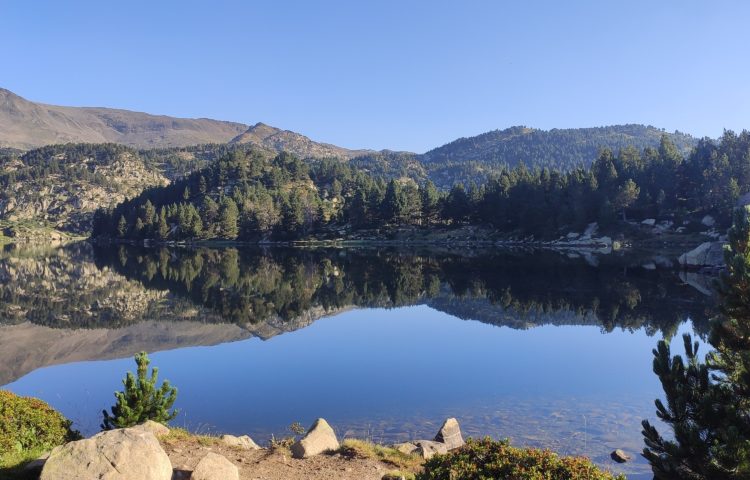Are you looking for a destination where you can explore amazing landscapes as well as fortresses and folklore from other times? Then the south of France and the multiple outdoors and cultural activities in Eastern Pyrenees might be just what you are searching.
The basics of our active holidays in Eastern Pyrenees, France:
Duration: 10 days
Date of travel: from July the 16th to July the 27th, 2022
Number of travellers: two people
Time of preparation: mostly improvised
In this post you will find a list of the main activities you can do while in your adventure holidays in Eastern Pyrenees. It ranges from trekking routes through breathtaking landscapes, lakes with tones of activities to do, Vauban fortresses or historical cult sites and cities.

The basics of our trip
The region of Eastern Pyrenees (Pyrénées-Orientales in French), also known as Northern Catalonia, is a department of Occitania in Southern France. The frontier with the Mediterranean Sea at the East and the Catalan Pyrenees are the main characteristics of this region. Therefore, it has a number of ski resorts and is a popular destination in winter. It is also full of possibilities for the summer time, which is when we visited.
We spent 10 days camping and doing activities in Eastern Pyrenees. We slept in three different places (Font Romeu, Prades and Saint Paul de Fenouillet) although this same trip can also be done while moving in a roadtrip or from a single location.
Although we were travelling as a couple, we felt that this was a destination very appropriate for families. We found plenty of kids from small ages to teenagers. All of them could find a range of activities to suit them.
While on holidays, we always tend to favor walking-type activities. However, on this occasion we added a little variety and the result is this list of outdoors and cultural activities in Eastern Pyrenees.
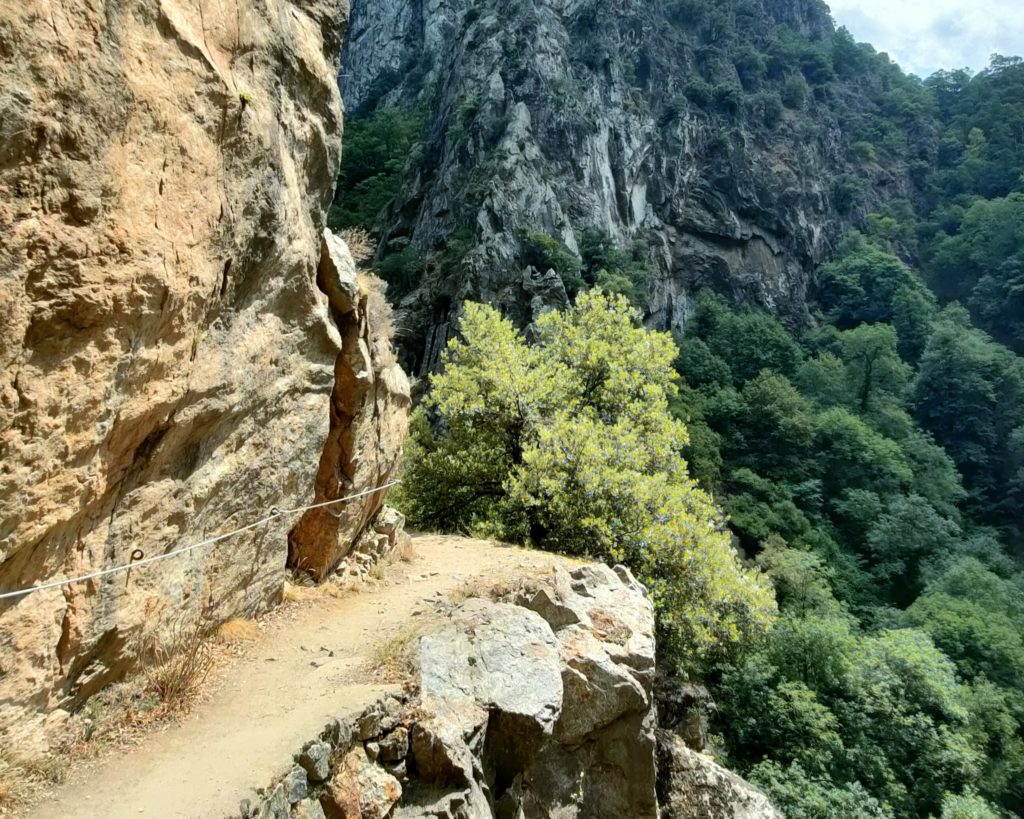
Main activities in Eastern Pyrenees
Gorges du Carança
Gorges du Carança is a walking/adventuring route you can do near the town of Thuès-Entre-Valls. The activity consists on following the river Carança when it crosses the rocks in the surroundings, leaving a spectacular canyon.
The main characteristic of this trail are its bridges and metalic walkways. You can either go and return through these walkways or aim for a circular: we started walking by the left side of the river and returned by the other side, which is where the walkways are located. The overall route consists on a 12km walk with approximately 400m of altitude gain.
We had planned it as a calm and easy walk and, although it is not extremely hard, it does present its difficulties and asks for more physical effort that we initially thought. It is totally worth it.
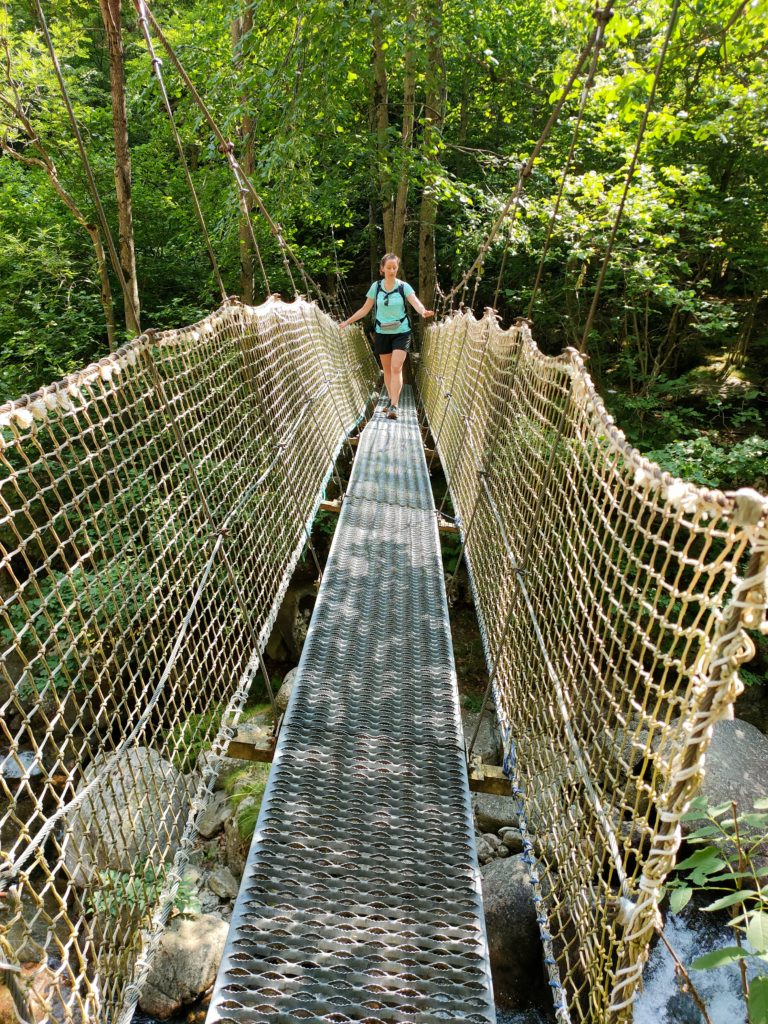
The human-made walkways consist on bridges to cross certain parts of the river or metallic platforms when walking alongside the water is not possible. There are like 10 of these human-made structures, ranging in its type and length.
It is worth noting that, starting from the parking (the beginning of the route), the first 5 or so structures are easiest to cross and more prepared for families, kids or in general for anyone not as accostumed to these activities. However, the remaining ones are more challenging mentally as they tend to be longer and you are more exposed.
The route it is also characteristic for its carved path in the mountains, quite narrow and high and maybe not apt if you suffer from vertigo. This kind of trail only lasts for 1.5km or so, but can be challenging if you are afraid of heights.

A similar destination is Gorges de la Fou, at Arles-sur-Tech. They are the narrowest canyon in the world and are located near the Gorges du Carança. The visit there consists on an easy short walk (less than 2km one way) over a metallic platform. However, it seems that due to some landslides in October 2018, visits are not permitted.
Villefranche de Conflent and visit to Fort Libéria
One of the cultural activities in Eastern Pyrenees, Villefranche de Conflent is one of the most beautiful towns in France. It was built in the 11th century and is filled with historical spots: from fortified walls to the pintoresque street of Saint John, the bridge of Saint Peter over the Têt or the bell tower.
Several restraurants and handicraft sotres are located in the streets of Villefranche de Conflent. But there are also other activities to do from the town, like visiting the caves in the surroundings or the Fort Libéria uphill guarding the town.
There are two main caves in Villefranche de Conflent: Cave Bastera which has free entrance and Cave of Canalettes, that you can visit for a fee. The schedule at Cave Bastera is more restricted, as it is closed at noon, so be sure to check it if this is something you want to do.
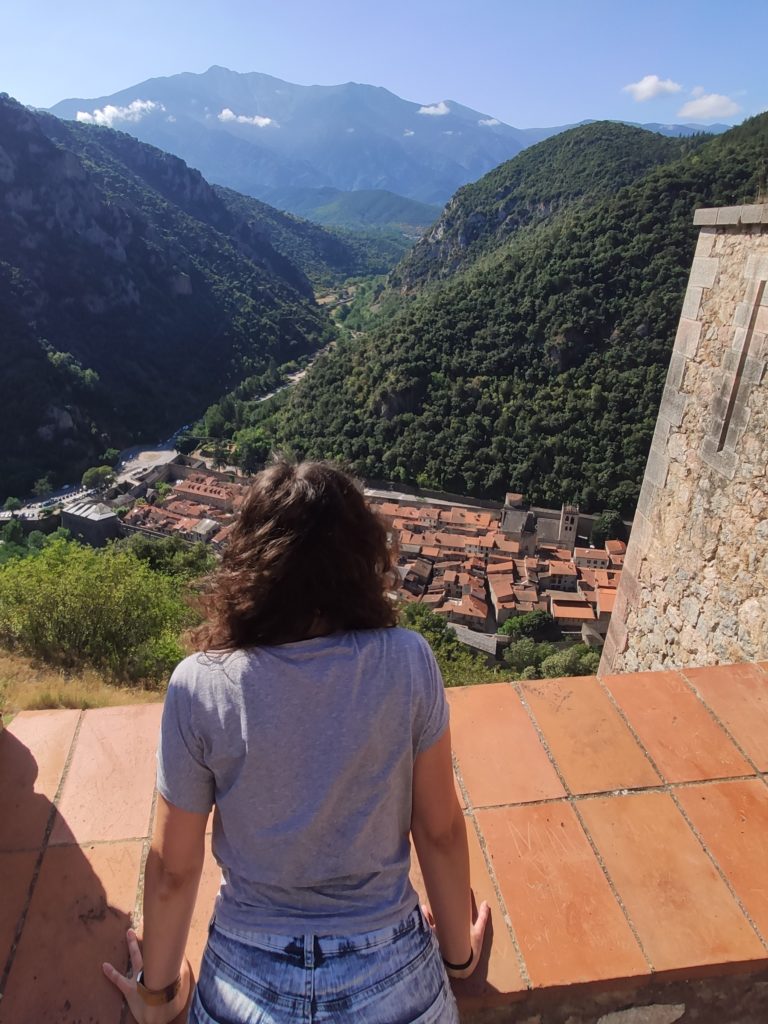
However, the main tourist attraction at Villefrache de Conflent is without a doubt Fort Libéria. Built in the 17th century by Marquis de Vauban to reinforce the defenses of the French sourthern border after the Treaty of Pyrenees in 1659 that gave the territory of Eastern Pyrenees, previously part of the Principality of Catalonia, to France.
You can access the Fort Libéria by:
- Climbing the 734 steps of the underground tunnel that connects the fortress with the city. It was built by Napoleon III and it is an experience on its own.
- Trekking from the town to the fortress (20 to 40 minutes).
- Taking a 4wd taxi that will leave you at the entrance of the fortress.
If enough people request it, a guided visited can be arranged once at Fort Libéria. However, when you arrive you will receive a sheet of paper with plenty of information to guide you along the fortress.
You will be visiting the three levels of defense of the fortress, as well as several rooms, corridors or prisons that are located in Fort Libéria.
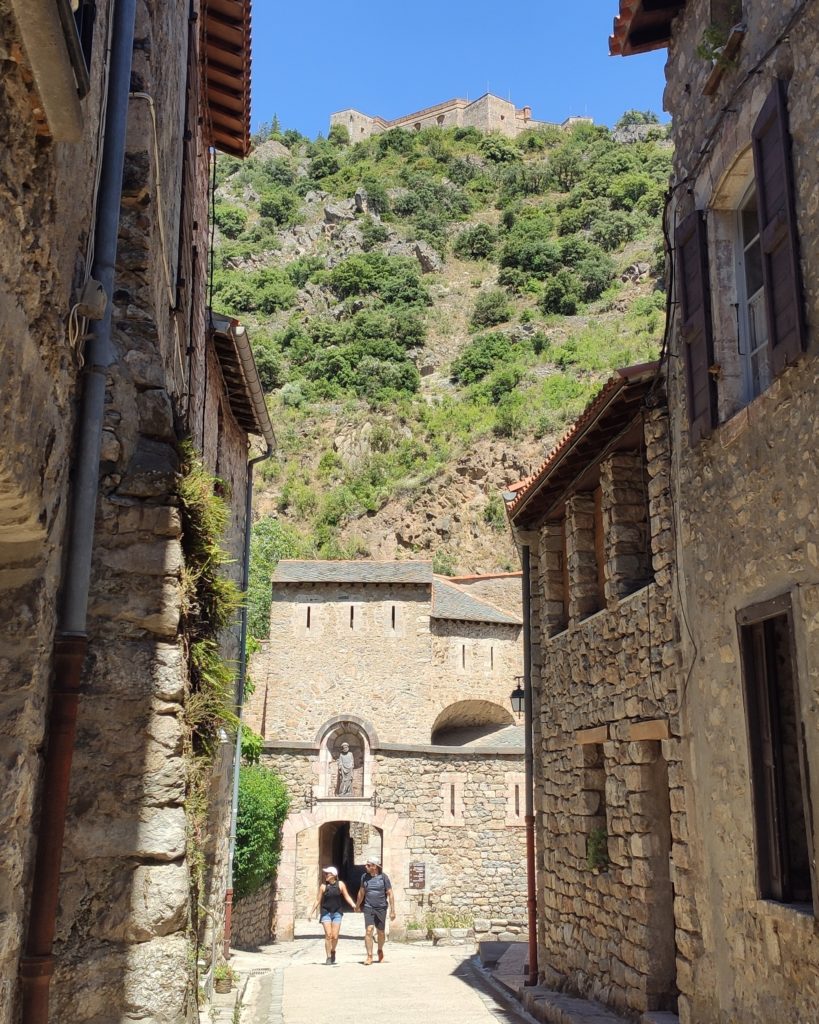
We do highly recommend that yo do not miss this piece of history! It was one of the highlights of our trip.
Town of Castelnou and panoramic views from Roc de Mallorca
Castelnou is another of the most beautiful towns of France and therefore one of the most visited ones. The activities there usually consist on visiting the town and its streets, festing at some of its multiple restaurants or buying handicrafts, honey and caramel-coated nuts.
In Castelnou you can also visit the viscount castle or the church of Sainte-Marie du Mercadal.
Another activity you can do to burn some extra callories and gain some bird-eye views of the area is climb to the small peak of Roc de Majorque. It is a 6km walk with 250m of altitude gain. Climbing and return can take 1.5 – 2 hours and you’ll gain some fantastic views over the landscape and the town, as well as the surrounding mountains.
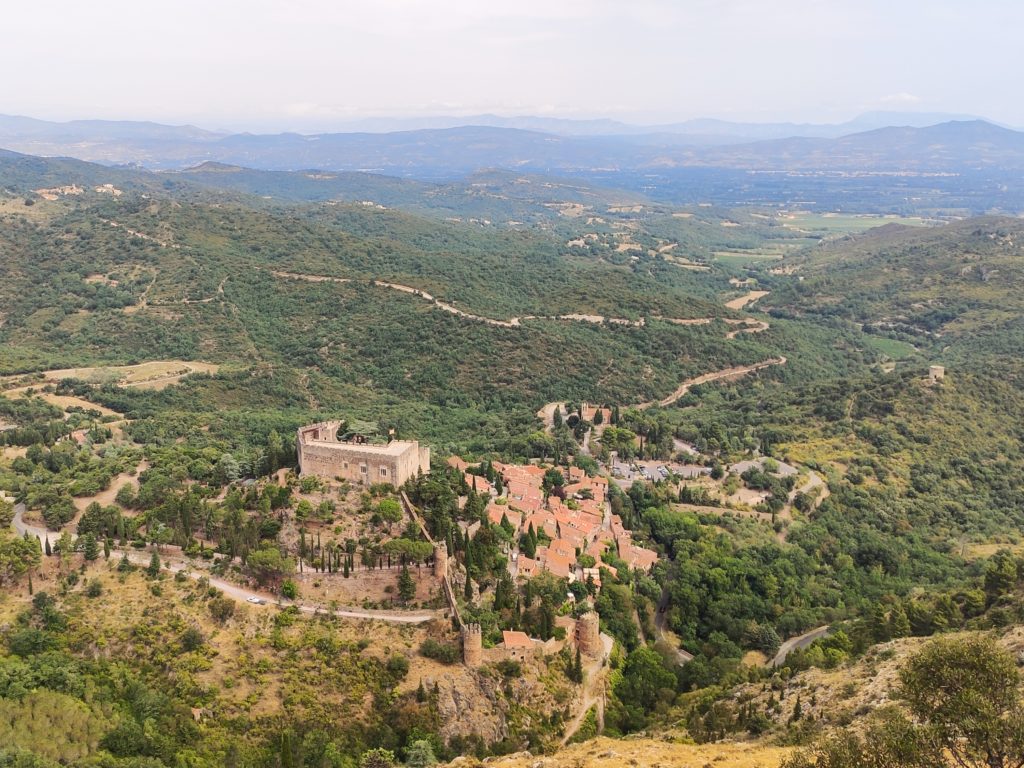
Abbaye Saint-Martin-du-Canigou
The Abbey of Saint-Martin-du-Canigou is located on the mountain of Canigou. Guifré II built the monastery in 1009. At the time, the region of Eastern Pyrenees was still part of the Princitality of Catalonia.
The monastery was originally populated by Benedictine monks until it was abandoned in 1783. It was restored in 1902 as a result of its risen popularity due to the publication of the poem ‘Canigou’ by Jacint Verdaguer, a catalan poet and priest regarded as one of the greatest poets in catalan literature. It is currently occupied by the Catholic Community of the Beautitudes.
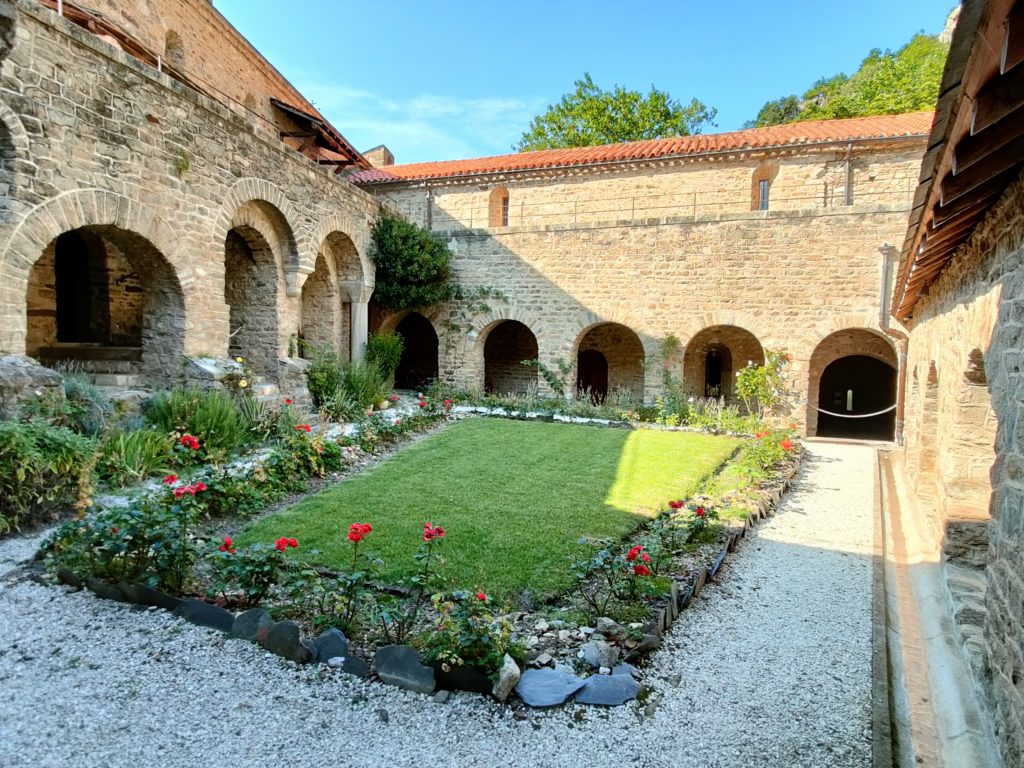
The abbey is located among mountains and the whole visit is of extreme beauty. It is not possible to arrive by car to the monastery itself, and you need to walk through the surrounding landscape for 20 to 60 minutes, depending on your path. The walk is uphill the whole time and through the forest, so I would recommend to wear good walking shoes.
The visit itself is guided but is only conducted in French. For other languages, they provide a sheet of paper with basic information. It lasts for about 90 minutes where you visit different parts of this romanesque style monastery.
We absolutely recommend this visit even if we didn’t understand a single thing of the guided tour. However, the arrival through the forest, the location of the monastery, its construction and for us also its history made for an incredible visit.
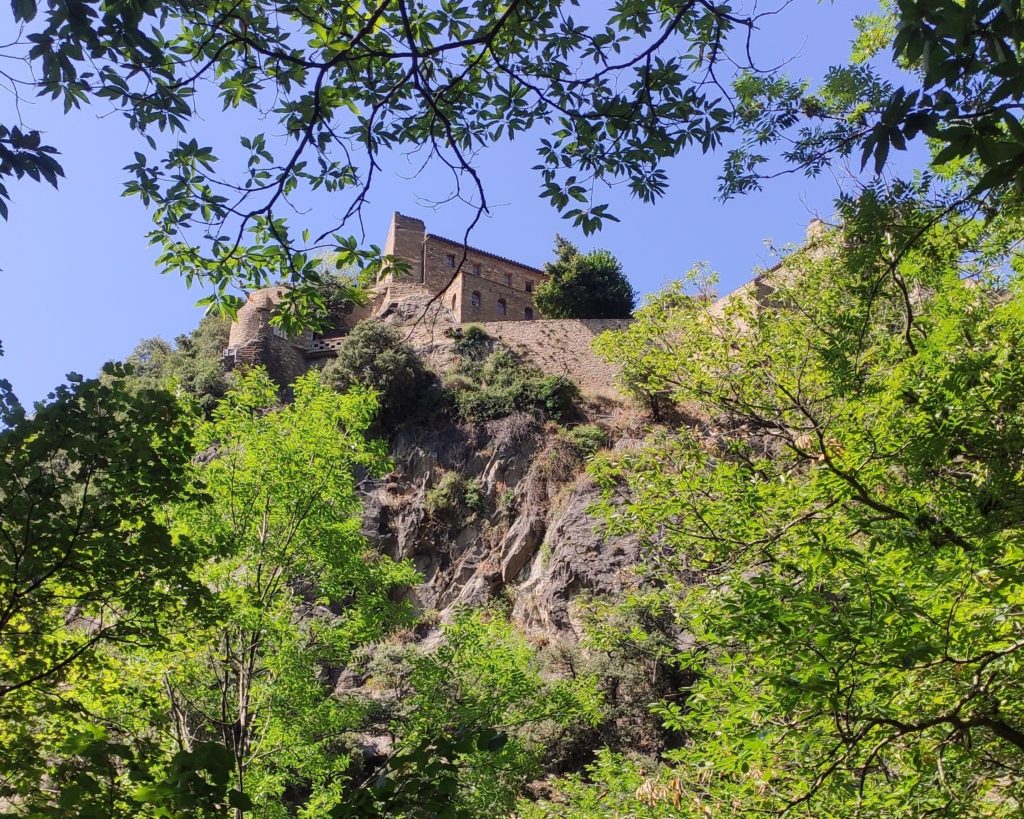
Pic du Canigou
Located in the Massif of Canigo, with its 2,784m of altitude the Pic du Canigou was considered until the 18th century the highest mountain of the Pyrenees, due to its dramatic prominence from its surroundings.
Every 22nd of June there is the ceremony of the ‘Flama del Canigó’ (Canigo’s Flame). It consists on people climbing the mountain, lighting a bonfire that they guard all night until next morning when they descend with flaming torches to the city of Perpignan. From there, the flame is distributed accross the Eastern Pyrenees, Catalonia, Valencian Community, Aragon and Balearic Islands. It is later used to light the bonfires on the celebrations of the night of Saint John’s.
Pic du Canigou has traditionally been one of the most climbed mountains in the area and the Pyrenees, due to its beauty and attainability. Routes have historically started at Refuge of Cortalets. This allows you to climb and return from Canigou in approximately 8km and 650m of altitude gain.

From 2018, the access to the parking near this refuge by car is forbidden and you needed to either add 16km and 1400m of altitude gain to the whole trekking or hire a 4wd taxi that left you at the refuge.
However, we learnt that from 2022 the access for these 4wd taxis is also forbidden leaving only the option of the longest route. We asked at tourism information offices and they told us that this measure is here to stay. I guess that from now on the ascend to Pic du Canigou will require and extraordinary physique or 2 days of trekking.
We were planning on hiring a 4wd taxi for this route. When we learnt it was not possible, we had to cancel the activity. If you want to climb Canigou, be aware of this new regulation and check up to date information.
Via Ferrata La Panoramique
Located in Saint-Paul-de-Fenouillet, this is the furthest activity we do from the area. It is a via ferrata of a difficulty of K3 (ranging from K1 being the easiest and K6 the hardest). In the same rock you can also find ‘La Pichona’. It is a K1 of 80m that is perfect for initiation or children.
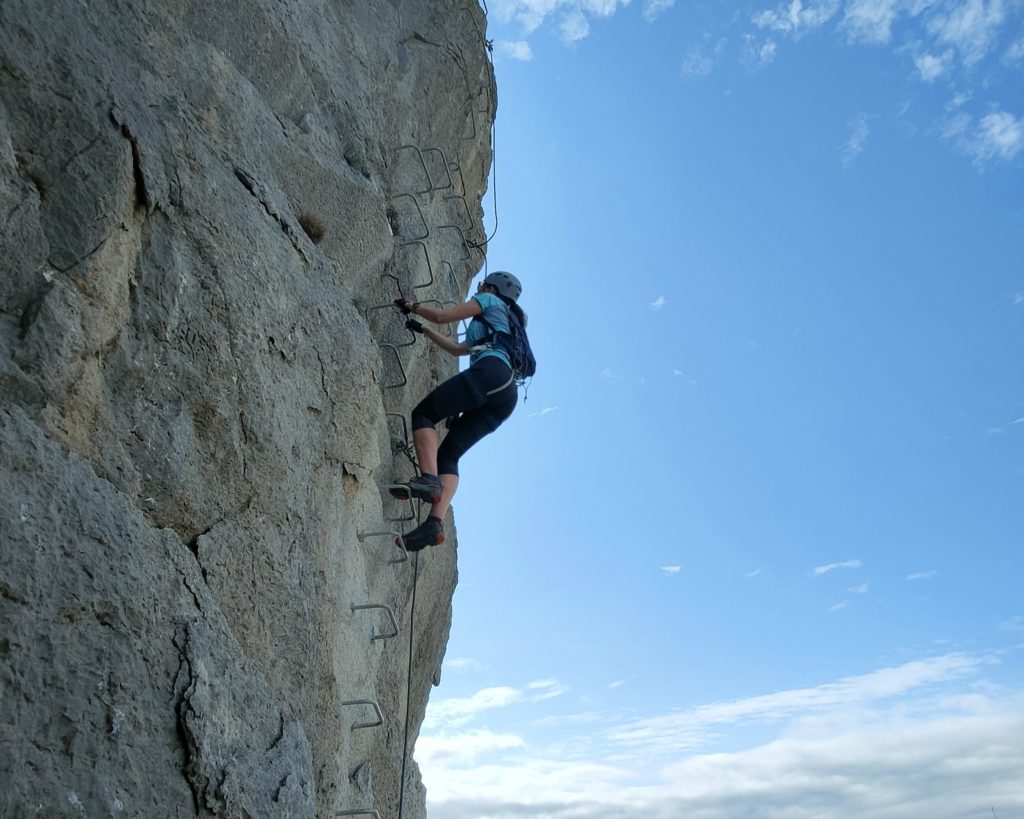
La Panoramique, which is the one we did, lasts for about 3 hours including the return to the car. The equipation is really good and you hardly need to use the rock. There are three short bridges along the via ferrata. You are kind of exposed for the majority of the time, passing through the crest for a while at the end.
It is overall entertaining and attainable, with the right amount of challenging. However, there are strong winds in the area. They were present when we did the ferrata, as they usually are. And it was an additional challenge that we had not expected. The winds where quite heavy and mentally draining as they were another factor adding difficulty. For example, I didn’t venture to do the bridges as I always do.
If you decide to do this ferrata (which would be a great decision), do consider that you will most probably also be encountering this wind.

Via Ferrata Les Escaldilles
We didn’t do this one but as it is in the area I want to list it for variety of activities in Eastern Pyrenees. It is located in the town of Llo, in Cerdagne. The via ferrata has two variants with different difficulty: Llisses de Llo (K3) and Llisses Dretes (K4).
In contrast with La Panoramique, you need to pay to access to these ferratas. Renting the material is mandatory. This is basicaly why we didn’t do it. We have our own material and don’t feel like paying extra just to wear a different one.
For this reason, I think that this ferrata would be more appropriate for a first contact with the activity, when you might go with a guide and rent material as you don’t have your own. This is an opinion only based on what I’ve read.
Lac des Bouillouses
Lac des Bouillouses, a human-made lake of extreme beauty surrounded by mountains and pine forest. From the lake, there are plenty of routes and activities you can do. For example:
- Climbing Carlit
- The 9 lakes of Carlit
- The 12 lakes of Carlit
- Circular around the Pradella
- The lake of Esquits
- Circular to the lake d’Aude
- Circular around La Borde

In the Lac de Bouillouses, there are some hotels where you can sleep. You also have the option to bivouac with your tent in certain areas, including some of the lakes. You can also find some gastronomical offer around the Lac. In case you want to either sleep or eat there, you should book in advance.
You can arrive there by car (with certain restrictions during summer), bus or chairlift. If you want information on how to arrive, check my other post:
Pic du Carlit
Carlit, with its 2,921m is the highest peak in the department of Pyrénées-Orientales and the region Languedoc-Roussillon, France. It is also among the most emblematic mountains in the area and therefore climbing Carlit is one of the most spectacular trekkings you can do there.
In Catalonia, which is where we are from, Carlit is also one of the most popular peaks because it is included on the list of the 100 mountains to climb (which paradoxically includes over 350), prepared by the catalan mountaineering federation, the ‘100 cims’.

The trekking route we did starts in the Lac des Bouillouses and passes next to the 12 Carlit lakes, even if we didn’t specifically visit them all. It is uphill the whole time.
- Starting and finishing point: Lac de Bouillouses at 2,016m (round trail)
- Highest spot: Carlit at 2,921m
- Altitude gain: 950m approximately
- Altitude loss: 950m approximately
- Distance: 15km round
- Total time: 7-8 hours
- Moving time: 5-6 hours
- Difficulty: moderate-high, both considering effort and terrain
If you want information on how to arrive to the starting point of the trek, a description of the route and the trail you will be walking and a few tips and utilities to take the most out of this experience, check my other post:
Mont-Louis
One of the nine citadels that Marquis de Vauban edified in France during the 17th century, after the addition of the Eastern Pyrenees region in 1659.
Mont-Louis is the highest (in altitude) fortified city in France. Its plaza is regarded as world heritage by UNESCO under Vauban fortresses. It is still in use today by the military as the national training centre for shock troops.
The visit through the city and the walk around the citadel is free. The access to the citadel is only possible through guided visit, purchased at the tourism office in Mont-Louis.

Mont-Louis solar furnace
Near the fortress of Mont-Louis, you can find the solar furnace of the town. Operating since 1949, it is a solar thermal energy facility, the first of this kind in the world, mainly used for research and educational purposes.
It is a huge infrastructure and very curious to visit.
Biking around Les Angles and Font Romeu ski resorts
Or any mountain range for that matter, as biking is one of the main activities in Eastern Pyrenees. We did it starting at the town of Font Romeu. There are plenty of stores where you can rent a bike in Font Romeu, including the camping we stayed at. We rented an electric bike.

Basicaly, the mountains in the area are full of trails that you can explore by bike. We searched some options in Wikiloc but at the end just took the map and explored on our own. The route we ended up completing was of 18km with heavy altitude gain in approximately 3 hours
We don’t usually explore the mountains by bike and it was our first time with an electric one. We felt it was an amazing way to cover greatest distances than by walking, particularly with the added help of the electricity. Also, the paths there are not of extreme technical difficulty and even if this is not an activity we are familiar with, we felt comfortable.

Lac du Matemale
At an altitude of 1,542, Lac du Matemale is a mandatory visit for kids and families for the enormous amount of water and leisure activities it offers. From exploring the lake either walking around its perimeter or canoeing, to horse or pony rides or dog sledding. There are also quad circuits for kids and inflatable castles or mini-golf.
Endnote
Was this list of outdoors activities in Eastern Pyrenees useful for you? Please let me know and feel free to ask any question in the comments section! You can also support my work and Buy Me A Coffe. I will be immensely happy 🙂
